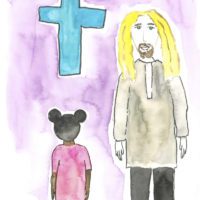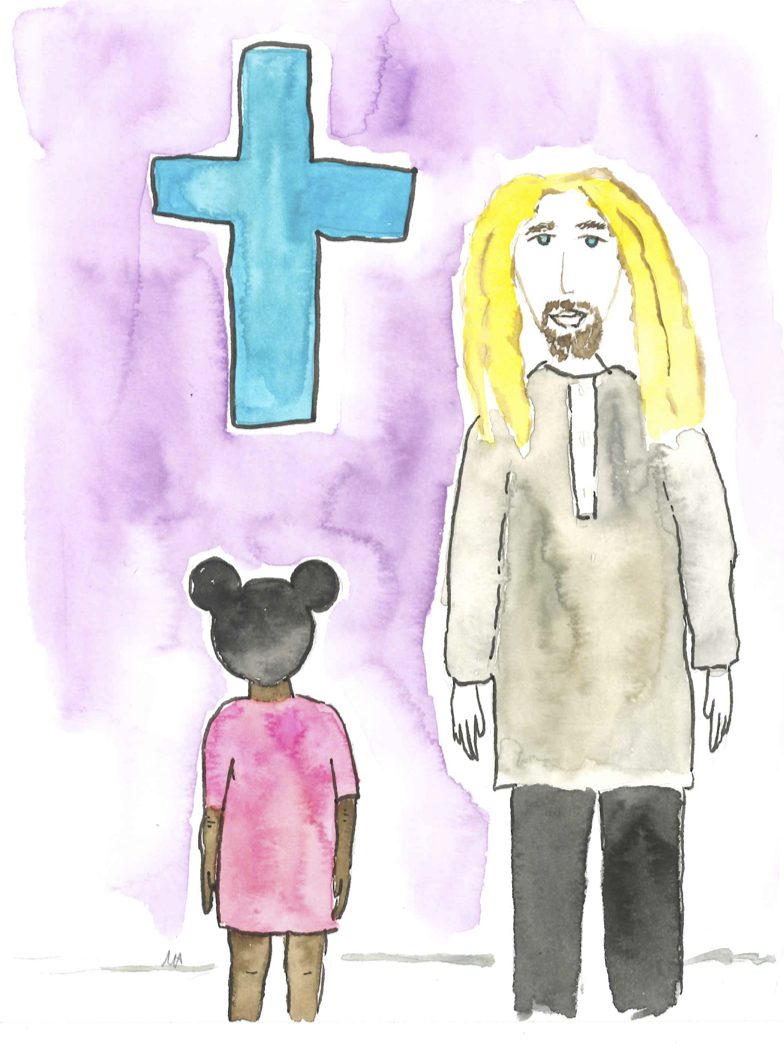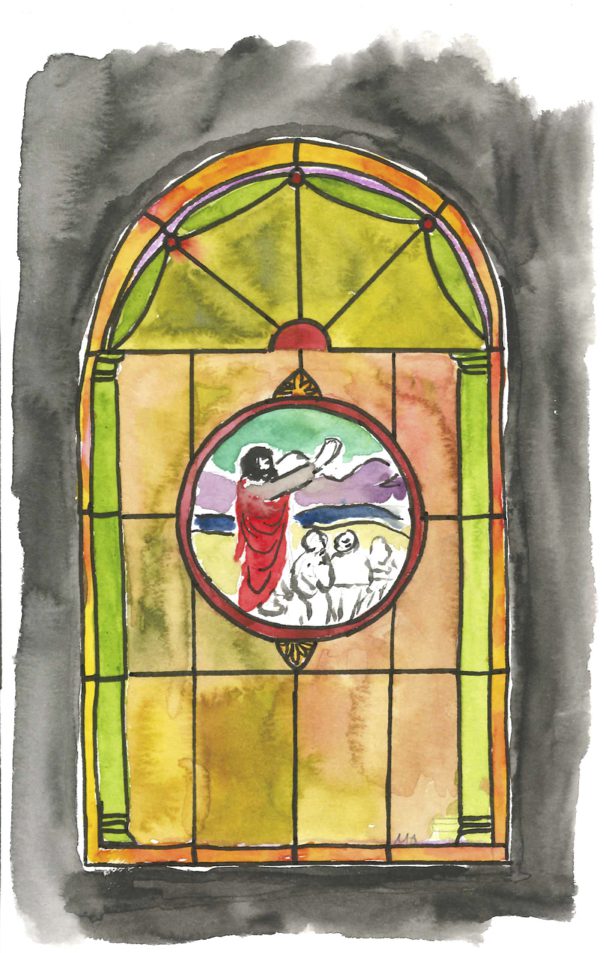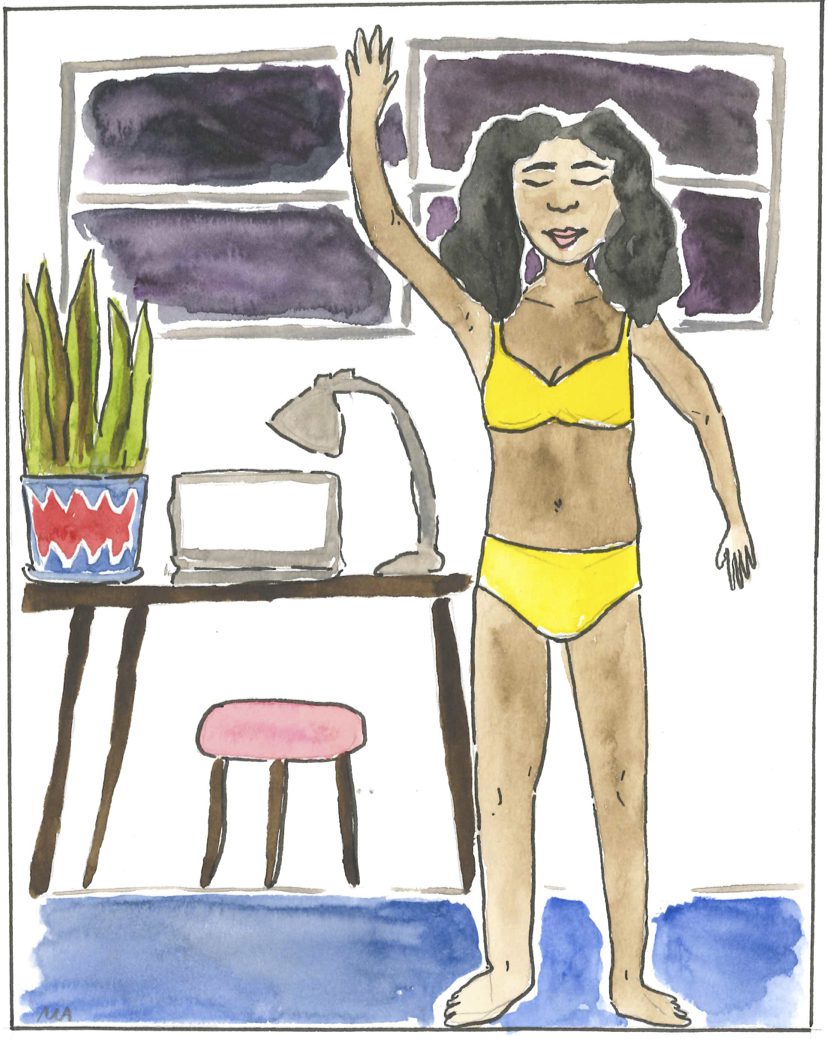I have a thing for white guys. I blame White Jesus.
Jesus was extra white when I was a young black Seventh-Day Adventist girl going to church every Saturday. We were one of two black families there. White Jesus was blonde-waves white. Skinny-nose white. Other-worldly white.
In naïve attempts to understand omnipotence and omnipresence, I conflated White Jesus with white men I knew, especially authority figures. Pastor Lemon was a White Jesus; Mr. Stall, the principal of my Adventist elementary and middle school, also White Jesus.
Around the age of six I insisted to my mom that my dad was white: not quite White Jesus but White Jesus-y.
Mom explained light-skinned.
Though I outgrew that impression of my dad, I didn’t move past my early ideas of whiteness as power and authority. The indoctrination every Saturday didn’t help me develop a more realistic understanding of what my Sabbath school teachers tried to tell me: “It’s not about color. Jesus loves all the little children: red, yellow, black, white. You’re all made in his image.” His image looked nothing like me but I still believed he gave his life for mine. I, like everyone else in the congregation, needed White Jesus to save me. That was the gist of all the stories, the gospel finally grounded.
Nearly every foundation of the Seventh-Day Adventist narrative—no surprise—emphasized that women need saving more than men. Eve got us in this wages-of-sin mess in the first place. Mary Magdalene, the whore, would have withered away in the gutter if she hadn’t lowered herself to wash a stranger’s feet, a stranger who, of course, rescued her from herself. Bathsheba bathed naked outside, bored with her husband, looking for a side piece.
My blackness, like my gender, was a sin. And with that, I was a believer, my fascination with needing to be saved now twisted in my adolescent sexuality, snared in the confusion about what it meant to be black. When I was fourteen, a white boy told me, flat out, that he wanted to take me to the spring formal but couldn’t because I was black. Any attention from a white boy was gold. His secret lust was a gift.
A year later, I met my first real Seventh-Day Adventist boyfriend. White Jesus sea-blue eyes, eyes so wet they looked as if they were always on the verge of tears. So much mercy. The school’s administration required that all students attend Wednesday’s chapel service in the assembly hall. In the cavernous room, the slightest whispers reverberated off the walls, singing as loud as the earnest-but-overconfident choir caterwauling a hymn which they always turned into an unnecessary round. The verses traveled in circles, tailing me all afternoon.
We were seniors, too cool to sit up front. While we sat in the back row with our friends who oohed and ahhed sarcastically at the songs of praise, Boy and I kept quiet. He always stared at the stage, seemingly rapt with the errant harmonies. Never shifting his gaze, he’d take his jacket off, drape it over both of us in the theater-style seats ever so conveniently close together. Then he’d feel me up. When the service was over, he’d ask me to join him at his church the coming Saturday. He said, “You need it.” So, I went.
I did not want to sit through the Saturday sermon, in the blue light of a bright winter sun coming through stained glass, but I did want him to feel me up during the weekly service at school. I told him, “I’m totally your temptress.” I liked how tacky it was. It felt devious, giving into baser instincts in the auditorium’s creaking seats, his hand riding up my shirt, my hand guiding his way. I was so irresistible, he had to touch me, even in the throes of prayer. His want, my worth.
I abandoned the Church completely after high school, worn down by the rules, the prayers, the monotony. Mostly, though, my mom stopped insisting I go. During my first year of college, I suffered through incessant major depressive episodes, sometimes thinking it was a punishment for sleeping in on Saturdays. The academic pressure sat heavy in my gut but my Obsessive-Compulsive Disorder made it easy to do well in class. I took notes, highlighted the notes, copied the notes into other notebooks, and recited the notes until I passed out, ink on my hands. Soon I couldn’t leave the compulsions long enough to go to class. I wasn’t going to survive.
And then, in the second semester of my sophomore year, I met an older man, married, fifteen years my senior. He wore a white button-down shirt with a ball point pen slid in between the second and third buttons. Four rubber bands circled his right wrist, as if, at any moment, he may need to secure something. He smelled like tobacco. White Jesus cheekbones.
He’d read every book ever written, I thought. He sang songs I’d never heard and sang them with so much heart they seemed to be gospel to him: Gregg Allman’s “Queen of Hearts”; Bonnie Raitt’s “Angel from Montgomery.” No matter how slow the song, the lyrics felt so fevered as he held his guitar, I swear, one time, I saw them burst out of his mouth, fiery as pages in the New Testament where Jesus’s words sit typeset in red.
My lord and savior.
My lord and savior.
The first time we slept together, we’d spent the day drinking obscene amounts of Miller Lite with his friends. I could barely stand by the time we were alone. He picked up his guitar. I lay down in a fetal position on his bed. I didn’t even sit up to sip the Jim Beam he offered me. I held the cup to the side of my mouth, letting a little of too-sweet bourbon between my lips, leaving the rest to dribble down my cheek, onto the thin pillowcase, sticky. When he got to the chorus of Bill Morrissey’s “Barstow,” singing, in a voice a little lower than normal, “I can’t believe it gets this cold,” I sat up and kissed him on the cheek, a kiss that was both permission and please? He’d been a bit cautious. But after I lay back down, he put his guitar on the floor, along with any hesitation. I was naked maybe forty seconds later.
The seventh commandment didn’t apply. For almost ten years, I played his ingenue and seductress. I kept our secrets. I think he liked our duality: the shame and the swagger. I did. And I didn’t just love the adultery. I loved the way he talked about my skin, how we watched black porn and tossed around “exotic.” I was fine with the hyper-sexualized identity we ascribed to my body, as if the very presence of my breasts was taboo, the darker shades between my legs.
What felt like agency in and out of bed—me feeling in control of my own fate, making choices to get rescued—was a delusion of grandeur. An illusion of self-esteem. In plain view, I played a part penned into my skin before I had a body. I was an object that mattered only when he held it in his gaze or in his hands. Hottentot Venus. Josephine Baker’s banana dance in France.
I loved him and loved who I was with him while hating myself with just as much guilty devotion. Now almost nine years since my last days with my last White Jesus (which included him confessing he had found a girl who “needed him” more, and my trip to an ill-equipped rural hospital for suicidal ideation, positive that I was nothing, my mother threatening to kill him) I sometimes catch myself thinking of how he saved me from my depression, anxiety, and every other aspect of myself. He earned my graduate degrees. He got my job. He gave me life.
Now white guys are falling from grace on the regular: in the newspaper, on TV, or even in Winn-Dixie, where a white man told me I should take off my tee shirt reading “Human Rights Are Not Optional” so he can “see the tits.”
I’m both aware and skeptical of their power, after years of watching the white world’s constant dismissal of black women and my subscribing to the idea that I deserve to be dismissed as an object, somehow both an embodiment and side effect of desire. I question any authority, especially any kind of savior, standing by as our country implodes.
When I think about my past—my beliefs and behaviors—what hurts me most is the fact that I turned my eye away from the possibilities not just of self-love, but of black love. At some point, I decided black men couldn’t “save me.” It wasn’t because they couldn’t save themselves; it was my misunderstanding of where love came from and what it meant, how I equated whiteness with the place where happily-ever-after’s eternity began.
I have a Bible somewhere in my apartment. Somewhere. But I know the exact location of my copy of Lucille Clifton’s Blessing the Boats. It stays open to her poem, “my dream about being white.”
She writes, “only white, / hair a flutter of / fall leaves.”
At the end of the poem, she removes the clothes of white history. She explains, “there’s no future / in those clothes.” Naked, she wakes up from the dream, dancing.
I’m a big fan of the one-woman dance party. I crank up Nina Simone’s “Tell Me More and More and Then Some” and get so caught up in my impromptu sway, eyes closed, I dance right into the desk. It leaves a bruise on my shin. I push my finger into the dark spot, watching the color slowly spread out and then return, flushed.
***
Rumpus original art by Maryam Afaq Ansari.







